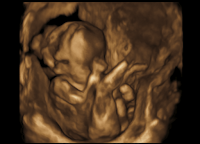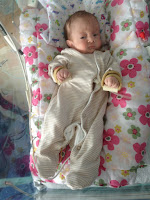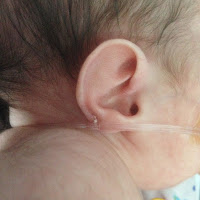I'm guessing that most people who read this will know this already, but we might as well start with an overview.
Trisomy: "an abnormality characterised by the presence of an additional chromosome to the normal diploid number". Chromosomes are the components of cells that carry the person's genes - often likened to striped socks, where a sock represents the chromosome and the stripes are the genes.
So everyone has 22 pairs of chromosomes (numbered 1-22) and a pair of sex chromosomes (XX for a girl or XY for a boy), for a total of 46 chromosomes. People who have a full trisomy, however, have 21 pairs of chromosomes, one triplet of chromosomes and the pair of sex chromosomes - 47 chromosomes in total - in every cell in their body.
The most common trisomy in live births is trisomy 21 (Down syndrome) which occurs in about 1 in 1,000 live births globally. The next most common is trisomy 18 (Edwards syndrome) which occurs in about 1 in 6,000 live births, and then trisomy 13 (Patau syndrome) which occurs in 1 in 10,000 live births. The frequency of all trisomies varies between countries depending on availability of abortion, average age of mothers and other factors.
Having an extra chromosome in every cell of your body causes a variety of physical and developmental issues. Your other genetic material will affect how your extra chromosome is 'expressed' (ie. the net effect of the extra chromosome on your body) so not everyone with for example trisomy 18 will have the same difficulties. However, all will have some features known to be linked to the condition.
Common features of fetuses/babies with T18
(more than 50% of cases)
- Low set ears (58%)
- Ventricular Septal Defect (VSD) (81%)
- Polyvalvular dysplasia (65%) (dysplasia of more than one heart valve)
- Overlapping fingers (71%)
- Growth retardation (87%)
 |
| Note the clenched fists |
|
 |
| Overlapping fingers after birth |
|
 |
| Low-set ears |
Less common features of fetuses/babies with
trisomy 18 (30-50% of cases)
- Micrognathia (small jaw) 48%
- Small face (35%)
- Abnormal ears (35%)
- Bicuspid aortic valve (45%)
- Bicuspid pulmonary valve (42%)
- Coarctation of the aorta (35%)
- Rocker bottom feet (39%)
- Club feet (32%)
 |
| Small face/small jaw |
|
 |
Note the long heel.
Rumer didn't have clear rocker-bottom feet |
|
 |
Not really rocker-bottom
feet |
|
 |
| Abnormal ears, note the missing flap |
|
All babies and children with full trisomy 18 have developmental delays, usually significant developmental delays. Because of their physical problems, many will require a lot of medical input to aid survival. This can include:
- Breathing support at birth due to pulmonary hypoplasia. Some will require ongoing breathing support ranging from tracheostomy-ventilation to nasal cannula oxygen because of ongoing lung issues.
- Cardiac medications and often surgery to repair underlying cardiac defects.
- Support with feeding due to small jaw, poor coordination of sucking and swallowing, and low tone (hypotonia). Most children with full T18 will need a feeding tube at least some of the time.
- Treatment for infections as, due to a small thymus, they have lower resistance to infection. They are also prone to aspiration pneumonias due to to feeding issues.
Children will also require developmental support from physiotherapists, occupational therapists, speech and language therapists and other services.
There is a high rate of mortality for children with full T18 (to be discussed in a future post) although intervention does seem to prolong survival.

No comments:
Post a Comment
Comments appear with some delay to allow moderation. Thanks for commenting!